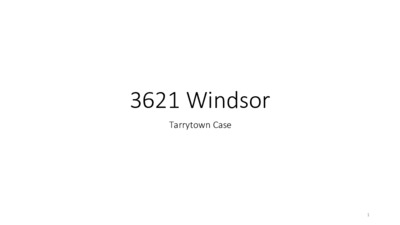D.5.1 - 3621 Windsor Rd - Presentation — original pdf
Backup

3621 Windsor Tarrytown Case 1 Tarrytown Case Summary The owner has requested a demolition permit for 3621 Windsor Rd., a Tarrytown residence. 2 Tarrytown Case Summary The owner has requested a demolition permit for 3621 Windsor Rd., a Tarrytown residence. Staff has argued that the structure may meet the architectural and historic association criteria. 3 Tarrytown Case Summary The owner has requested a demolition permit for 3621 Windsor Rd., a Tarrytown residence. Staff has argued that the structure may meet the architectural and historic association criteria. However, the structure has been meaningfully expanded and changed over time – and staff’s basis for historic association raises equity-related policy questions. 4 This Tarrytown residence was owned by oilwoman philanthropist Alma Thomas. It was built in the late 1940s for $52,500 – roughly 12 times the median home value at that time. This is the structure as it existed the year Alma Thomas passed – it included a main house and servants’ quarters. 6 This is the structure as it today – meaningful work has been done to expand and change it. 7 Historic Association Rationale: Equity Implications Staff argues that Alma Thomas’ status as an oilwoman and local philanthropist is sufficient to warrant historic designation for this structure. 8 Historic Association Rationale: Equity Implications Staff argues that Alma Thomas’ status as an oilwoman and local philanthropist is sufficient to warrant historic designation for this structure. However, adopting this rationale would disproportionately favor historic designation in affluent West Austin, where residents had a much greater capacity to participate in large-scale philanthropy. 9 Historic Association Rationale: Equity Implications Staff argues that Alma Thomas’ status as an oilwoman and local philanthropist is sufficient to warrant historic designation for this structure. However, adopting this rationale would disproportionately favor historic designation in affluent West Austin, where residents had a much greater capacity to participate in large-scale philanthropy. This would also provide these affluent areas with tax exemptions and abatements. In other words, past wealth would be used as a basis for shifting today’s tax burden onto less affluent Austinites. 10 Already, there are six historic landmarks with a half-mile of this property. 11 Supporting Conditions Alma Thomas Has Been Appropriately Honored by Southwestern University. Southwestern University has honored Thomas with the Alma Thomas Fine Arts Center, connecting her to the work she did and the causes she supported. Alma Thomas’ Granddaughter Opposes Historic Designation. Thomas’ granddaughter has written that this case “would connect my grandmother to a house rather than to the world she explored and the trailblazing work that she did” and has asked the Commission “Please do not use my grandmother as a justification for [initiating or approving historic zoning].” 15 Alma Thomas has been appropriately honored by Southwestern University, connecting her to the work that she did and the causes she supported. Recap The owner – as well as Alma Thomas’ granddaughter, who has no financial interest in the outcome of this case – both request that you release the demolition permit for 3621 Windsor Rd. 14 Recap The owner – as well as Alma Thomas’ granddaughter, who has no financial interest in the outcome of this case – both request that you release the demolition permit for 3621 Windsor Rd. Staff has argued that the structure may meet the architectural criteria, but the structure has been meaningfully expanded and changed since Thomas’ lifetime. 15 Recap The owner – as well as Alma Thomas’ granddaughter, who has no financial interest in the outcome of this case – both request that you release the demolition permit for 3621 Windsor Rd. Staff has argued that the structure may meet the architectural criteria, but the structure has been meaningfully expanded and changed since Thomas’ lifetime. Additionally, staff’s rationale for historic association – if applied consistently – raises a number of policy questions related to equity and preferential treatment for historically affluent communities. 16